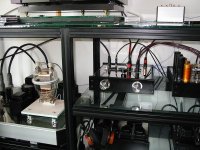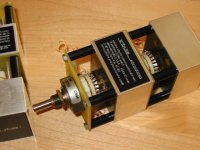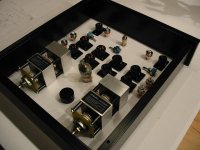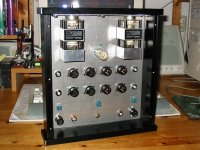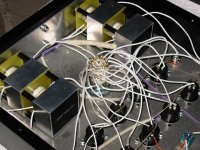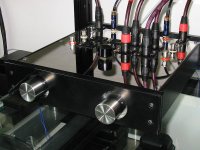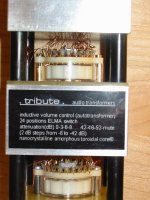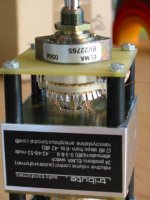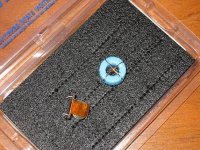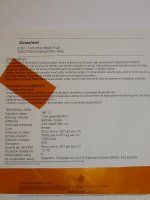Hi all,
where to put this subject ? Just finished my preamp......but it is out of most catagories.
So i put it between the amplifiers (although it amplifies nothing, it only makes the signal weaker). And why between tubes: because the rest of the system is all tubes. Passive's do seem to have a higher attraction to tube-addicted people anyway.....
The result is a minimalistic:
- 4 x balanced in;
- 2 x RCA in;
- switchable balanced (to power amplifier) or RCA (to headphone amplifier) out;
- ground lift.
Very open and detailed. Before this i had a active preamp which was good.....but not so "natural" as this passive one.
Regards,
Reinout
where to put this subject ? Just finished my preamp......but it is out of most catagories.
So i put it between the amplifiers (although it amplifies nothing, it only makes the signal weaker). And why between tubes: because the rest of the system is all tubes. Passive's do seem to have a higher attraction to tube-addicted people anyway.....
The result is a minimalistic:
- 4 x balanced in;
- 2 x RCA in;
- switchable balanced (to power amplifier) or RCA (to headphone amplifier) out;
- ground lift.
Very open and detailed. Before this i had a active preamp which was good.....but not so "natural" as this passive one.
Regards,
Reinout
Attachments
inductive switches
Hi again,
in the following post i'll give some explanation + pictures of the passive preamp.
Here's a picture of the switch itself:
- this one is formally stereo. I use 2 of them for i wanted to attenuate the balanced signals properly;
- main ingredienst are permally cores, an ELMA 24-step switch and lots of time winding the coils !;
- nicely potted. It's definitely high quality. Nothing wobbly on the items;
Remember, these are coils and not transformers.
Sowter uses the transformer style (so with primary and secondary coil). These Tribute's are "only" coils with only the primary.
Brand: Tribute. This brand is into anything what has to do with transformers/coils/tubes/audio. Normally he makes only stuff for private persons, but once in a while you see Tribute-items in other brands as well. For instance in those weird and out-of-this-world Electronluv stuff.
I think i must be lucky to live in such a small country where you can buy these items. The owner/winder of these goodies even brought them to my house in person !
I saw complaints from fellow DIY-builders with delivery-speed of Tribute. It's a one-person business, and even not his primary job ! For him it's a hobby and the goal is high quality. Give the man a break and let him do his stuff. Rest assured: your order will come through and will be of the highest standard.
Sorry....not affiliated with this guy.....but i'm simply afraid the audio community will lose some of it's treasures.
Reinout
Hi again,
in the following post i'll give some explanation + pictures of the passive preamp.
Here's a picture of the switch itself:
- this one is formally stereo. I use 2 of them for i wanted to attenuate the balanced signals properly;
- main ingredienst are permally cores, an ELMA 24-step switch and lots of time winding the coils !;
- nicely potted. It's definitely high quality. Nothing wobbly on the items;
Remember, these are coils and not transformers.
Sowter uses the transformer style (so with primary and secondary coil). These Tribute's are "only" coils with only the primary.
Brand: Tribute. This brand is into anything what has to do with transformers/coils/tubes/audio. Normally he makes only stuff for private persons, but once in a while you see Tribute-items in other brands as well. For instance in those weird and out-of-this-world Electronluv stuff.
I think i must be lucky to live in such a small country where you can buy these items. The owner/winder of these goodies even brought them to my house in person !
I saw complaints from fellow DIY-builders with delivery-speed of Tribute. It's a one-person business, and even not his primary job ! For him it's a hobby and the goal is high quality. Give the man a break and let him do his stuff. Rest assured: your order will come through and will be of the highest standard.
Sorry....not affiliated with this guy.....but i'm simply afraid the audio community will lose some of it's treasures.
Reinout
Attachments
lay out preamp
The lay out of the preamp was simple indeed:
- volume knobs at the front;
- at the topplate the selector switch;
- the switches XLR/RCA out at the end;
- fill the rest with the connectors;
Topplate and bottomplate are 2 mm stainless steel. The housing itself is 15 mm aluminium. I use this style throughout my whole set.
The eye is listeling as well !
Reinout
The lay out of the preamp was simple indeed:
- volume knobs at the front;
- at the topplate the selector switch;
- the switches XLR/RCA out at the end;
- fill the rest with the connectors;
Topplate and bottomplate are 2 mm stainless steel. The housing itself is 15 mm aluminium. I use this style throughout my whole set.
The eye is listeling as well !
Reinout
Attachments
tribute adres
Good morning analog_sa,
thanks for the compliment.....and how about your DIY-projects ?
Tribute: website (a bit old...but there is a contact email-adres):
http://www.tribute-audio.nl
My poweramps have a 10K input transformer...and working woth tapped transformers as a preamp is not very nice doing that with those impendances. You're bound to lose high notes.
That's why i'm using autoformers....and it works very well without the rol-off.
Another issue with my set up: i can squeeze 5V from my CD-player....and the switches must be able to withstand that.
Again: no problem.
Sorry...never measured the inductance. But i'm sure Pieter (of Tribute) does have that figure available.
Another builder with these goodies measured the frequency throughput:
- full open (no attenuation): 2 Hz - 2 MHz
- half open (halfway): 5 Hz - 105 KHz
And no popping noises during switching !
Pricewise: i bought them last year while still almost prototype. Don't know the current productionprice. I believe it spend € 275 for 2 switches....but please don't hold me to that number.
Positive: you do not need to buy a quality switch when ordering these attenuators....the ELMA-switch is part of the complete package.
Reinout
Good morning analog_sa,
thanks for the compliment.....and how about your DIY-projects ?
Tribute: website (a bit old...but there is a contact email-adres):
http://www.tribute-audio.nl
My poweramps have a 10K input transformer...and working woth tapped transformers as a preamp is not very nice doing that with those impendances. You're bound to lose high notes.
That's why i'm using autoformers....and it works very well without the rol-off.
Another issue with my set up: i can squeeze 5V from my CD-player....and the switches must be able to withstand that.
Again: no problem.
Sorry...never measured the inductance. But i'm sure Pieter (of Tribute) does have that figure available.
Another builder with these goodies measured the frequency throughput:
- full open (no attenuation): 2 Hz - 2 MHz
- half open (halfway): 5 Hz - 105 KHz
And no popping noises during switching !
Pricewise: i bought them last year while still almost prototype. Don't know the current productionprice. I believe it spend € 275 for 2 switches....but please don't hold me to that number.
Positive: you do not need to buy a quality switch when ordering these attenuators....the ELMA-switch is part of the complete package.
Reinout
Attachments
more info
Hi analog_sa,
the other builder (at www.dhtrob.com but in dutch) also measured resistance and inductance on the switches:
- 35 ohm resistance;
- 180 He inductance (at customer specification).
As you already use the T102 you know the pro's of an autoformer:
- at high attenuation ( = low volume) still enough inductance to have correct low throughput;
- source sees constant inductance AND low resistance.....easy load.
Hope this answers your questions ?
Reinout
Hi analog_sa,
the other builder (at www.dhtrob.com but in dutch) also measured resistance and inductance on the switches:
- 35 ohm resistance;
- 180 He inductance (at customer specification).
As you already use the T102 you know the pro's of an autoformer:
- at high attenuation ( = low volume) still enough inductance to have correct low throughput;
- source sees constant inductance AND low resistance.....easy load.
Hope this answers your questions ?
Reinout
Attachments
Hope this answers your questions ?
Yes, thank you very much.
Reinout, nice work! I am fond of Pieter and am currently communicating with him about wiring some teflon-enameled silver wire transformers. His work takes time, but that's the cost of artisanal quality and the price paid for attention to low-quantity requirements.
If we can get the teflon thin enough---which I think we can---the transformer should be quite some nice sounding transformer! Teflon has a lower dielectric constant, which will make up for certain losses attributable to the larger size of teflon enameled wire. The lower dielectric constant also should remove a layer of mud attributable, in principle, to dielectric effects of typical enamel (akin to swapping a teflon for mylar capacitor). I'm running as the guinea pig for this project, which might not work. Hey, but if it does ..... And more, the project might lead to a set of very high end products made by Tribute .... Pieter willing, of course.
And more, the project might lead to a set of very high end products made by Tribute .... Pieter willing, of course.
If we can get the teflon thin enough---which I think we can---the transformer should be quite some nice sounding transformer! Teflon has a lower dielectric constant, which will make up for certain losses attributable to the larger size of teflon enameled wire. The lower dielectric constant also should remove a layer of mud attributable, in principle, to dielectric effects of typical enamel (akin to swapping a teflon for mylar capacitor). I'm running as the guinea pig for this project, which might not work. Hey, but if it does .....
Willing guinea pig....
Good evening Tom,
at least...evening on this side of the world.
I'm looking forward to your results with the silver wire. Till now everything was copper. And i have no reason to complain. The sound of all these goodies is simply musical.
But new projects....new insights.....new audio-fanatics....it is what this hobby is all about ?!
Just as your idea with the teflon coating, i had a plan with the stereo attenuator switch for a balanced volume control. Of course i needed 2 switches, but the quality of these switches had to be perfect. I explained my fears to Pieter and he came up with "matched" switches where the 2 coils were really the same. They are working great. You can leave those fine details to him.
I spoke with him 2 days ago andd till now i'm the only one using these stereo-switches as balanced volume controls.
And just like any artist: he needs time. For any potential buyer of goodies from this chap: do your planning in advance and then you have only to wait for the high quality stuff he delivers.
In the meantime my next project is underway: a DAC. But that will really take some time for my present job is quite time consuming.
I did my planning and ordered a SPDIF transformer to specification.
On the picture you can see a Lundahl LL1566 and the Tribute permalloy one (blue). When the project is finished i'll post the results on this forum.
May i be so impolite and ask for the results of your teflon-coating-progress ? Exactly what kind of transformers are buying designed: output / input / interstage ?
Reinout
Good evening Tom,
at least...evening on this side of the world.
I'm looking forward to your results with the silver wire. Till now everything was copper. And i have no reason to complain. The sound of all these goodies is simply musical.
But new projects....new insights.....new audio-fanatics....it is what this hobby is all about ?!
Just as your idea with the teflon coating, i had a plan with the stereo attenuator switch for a balanced volume control. Of course i needed 2 switches, but the quality of these switches had to be perfect. I explained my fears to Pieter and he came up with "matched" switches where the 2 coils were really the same. They are working great. You can leave those fine details to him.
I spoke with him 2 days ago andd till now i'm the only one using these stereo-switches as balanced volume controls.
And just like any artist: he needs time. For any potential buyer of goodies from this chap: do your planning in advance and then you have only to wait for the high quality stuff he delivers.
In the meantime my next project is underway: a DAC. But that will really take some time for my present job is quite time consuming.
I did my planning and ordered a SPDIF transformer to specification.
On the picture you can see a Lundahl LL1566 and the Tribute permalloy one (blue). When the project is finished i'll post the results on this forum.
May i be so impolite and ask for the results of your teflon-coating-progress ? Exactly what kind of transformers are buying designed: output / input / interstage ?
Reinout
Attachments
Hi Reinout,
I've asked Pieter to wind a pair of output transformers for 300B. Some while ago, I purchased some teflon coated silver wire from a manufacturer in the US. The cost was reasonable ... US$1.20 per foot for 24AWG 99.99% silver. The teflon coating on that wire is possibly too thick for transformer purposes, though maybe not, but in any event tested to over 5000VDC with no problems (think high voltage output transformer!). I'll let you know the results of our experimenting. Feel free to ask Pieter yourself about his thoughts and any progress he's made on this project.
My intuition tells me that dielectric absorption on regular enamel wire is a sonic detriment greater than a small loss of bandwidth arising from using thicker (teflon) coating on transformer wire. Our experiment will determine whether this is true.
Silver wire, of course, renders a transformer rather expensive, but such transformer should last a lifetime with little degradation given the nature of silver wire.
Cheers!
I've asked Pieter to wind a pair of output transformers for 300B. Some while ago, I purchased some teflon coated silver wire from a manufacturer in the US. The cost was reasonable ... US$1.20 per foot for 24AWG 99.99% silver. The teflon coating on that wire is possibly too thick for transformer purposes, though maybe not, but in any event tested to over 5000VDC with no problems (think high voltage output transformer!). I'll let you know the results of our experimenting. Feel free to ask Pieter yourself about his thoughts and any progress he's made on this project.
My intuition tells me that dielectric absorption on regular enamel wire is a sonic detriment greater than a small loss of bandwidth arising from using thicker (teflon) coating on transformer wire. Our experiment will determine whether this is true.
Silver wire, of course, renders a transformer rather expensive, but such transformer should last a lifetime with little degradation given the nature of silver wire.
Cheers!
serengetiplains said:My intuition tells me that dielectric absorption on regular enamel wire is a sonic detriment greater than a small loss of bandwidth arising from using thicker (teflon) coating on transformer wire.
What detriment would dielectric absorption bring about other than a miscroscopically small loss of bandwidth anyway?
By the way, silver wire with Teflon insulation is available with insulation thicknesses comparable to that of double build magnet wire enamel.
se
dielectric
Hello Tom,
a real audio-fanatic: not willing to accept the standard solution, but investigating new ideas. I really like that. Of course it will take time and money but if it works.......
And why wouldn't it work. Look at all these high-end interconnects and speakercables. The dielectric is one of THE items they're all about. So i think you have a real point looking deeper into this subject.
As what Steve Eddy brings into this discussion: theoretically a thicker insulation will loose some bandwith. You simply can't beat physics here. But the difference in dielectric is worth experimenting anyway. I use 24 AWG 99.99 % silver as interconnects. And i experimented with different kind of laquers to coat them and/or use different kind of sleeving. After some time i found out i preferred PU-laquer or teflon-sleeving the most. The laquer came from a shop which impregnates wooden floors.....these were the left-overs from one of their jobs. A very cheap solution.
And if there are already differences with a meter of interconnect: why not in a signal transformer ?
For the B+ power supply transformer of my 833-amplifier (1000 ~1400 V) i requested to use Kapton as the insulation between the primaries/secondaries. Kapton: very nice stuff ! It can take a 7500 V hammering and heat and is extremely thin. Especially the thickness attracted me for now i lost less space to the more classic used Kraft-paper insulation. And i was able to use thicker wire and hence lower resistance.
Included the Kapton datasheet. The 2 pieces of "orange transparant plastic" is the stuff itself.
Regards,
Reinout
Hello Tom,
a real audio-fanatic: not willing to accept the standard solution, but investigating new ideas. I really like that. Of course it will take time and money but if it works.......
And why wouldn't it work. Look at all these high-end interconnects and speakercables. The dielectric is one of THE items they're all about. So i think you have a real point looking deeper into this subject.
As what Steve Eddy brings into this discussion: theoretically a thicker insulation will loose some bandwith. You simply can't beat physics here. But the difference in dielectric is worth experimenting anyway. I use 24 AWG 99.99 % silver as interconnects. And i experimented with different kind of laquers to coat them and/or use different kind of sleeving. After some time i found out i preferred PU-laquer or teflon-sleeving the most. The laquer came from a shop which impregnates wooden floors.....these were the left-overs from one of their jobs. A very cheap solution.
And if there are already differences with a meter of interconnect: why not in a signal transformer ?
For the B+ power supply transformer of my 833-amplifier (1000 ~1400 V) i requested to use Kapton as the insulation between the primaries/secondaries. Kapton: very nice stuff ! It can take a 7500 V hammering and heat and is extremely thin. Especially the thickness attracted me for now i lost less space to the more classic used Kraft-paper insulation. And i was able to use thicker wire and hence lower resistance.
Included the Kapton datasheet. The 2 pieces of "orange transparant plastic" is the stuff itself.
Regards,
Reinout
Attachments
Further re dielectric
Hi Reinout, yes, fanatical about audio!
Re your comment above, that's my thought precisely: if a wire's dielectric is audible in a one-foot piece of wire, the dielectric should be the more audible in a thousand feet. The closer one can budge the dielectric constant of a wire's insulation to that of air, the less influence that dielectric will have on the signal. This is not esoteric stuff, and is accepted by non-audio and, in audio, non-hifi industries whose concerns for signal integrity don't reach the level of those of the typical audiophile (I'm thinking here, among other things, of the various foam dielectrics used in cables of many a sort).
I also suspect that for long runs of cable, such as are used in a transformer, that variations in wire thickness emerge as a small but audible influence on the sound. The wire I will spec for the guinea pig transformers will be of a precise polished diameter .... for an additional small cost.
Nice work with the kapton!
ReinoutdV said:And if there are already differences with a meter of interconnect: why not in a signal transformer ?
Hi Reinout, yes, fanatical about audio!
Re your comment above, that's my thought precisely: if a wire's dielectric is audible in a one-foot piece of wire, the dielectric should be the more audible in a thousand feet. The closer one can budge the dielectric constant of a wire's insulation to that of air, the less influence that dielectric will have on the signal. This is not esoteric stuff, and is accepted by non-audio and, in audio, non-hifi industries whose concerns for signal integrity don't reach the level of those of the typical audiophile (I'm thinking here, among other things, of the various foam dielectrics used in cables of many a sort).
I also suspect that for long runs of cable, such as are used in a transformer, that variations in wire thickness emerge as a small but audible influence on the sound. The wire I will spec for the guinea pig transformers will be of a precise polished diameter .... for an additional small cost.
Nice work with the kapton!
jam said:...................transformer man is back!
Naah. My Transformer Man suit and cape are temporarily hanging in the closet. Lately I'm known as Box Boy.
se
Re: dielectric
What they really seem to be all about is chasing after numbers. It's rather like the Spec Wars of the 60s and 70s where manufacturers were competing for the best numbers in terms of THD, IM, SN, etc. It's just been taken to a different level. Cable manufacturers compete for a different set of numbers. Dielectrics with the lowest dielectric constant, conductors with the highst conductivity, the highest purity, the fewest cyrstals, etc.
And just as back then the status quo seems to equate better numbers with better quality. Back then, people like Gordon Holt challenged the objectivist status quo. The best numbers didn't always result in the best sound. That started the subjectivist revolution where numbers were no longer obsessed over and chased after.
Ironically it seems we've now come full circle.
Actually I wasn't speaking to the thicker insulation, but rather pointing out that the higher dielectric absorption of the more common insulations used for magnet wire (such as polyurethane) will simply result in a microscopically reduced bandwidth.
Essentially I was just questioning the obsession over numbers such as dielectric constant.
se
ReinoutdV said:And why wouldn't it work. Look at all these high-end interconnects and speakercables. The dielectric is one of THE items they're all about.
What they really seem to be all about is chasing after numbers. It's rather like the Spec Wars of the 60s and 70s where manufacturers were competing for the best numbers in terms of THD, IM, SN, etc. It's just been taken to a different level. Cable manufacturers compete for a different set of numbers. Dielectrics with the lowest dielectric constant, conductors with the highst conductivity, the highest purity, the fewest cyrstals, etc.
And just as back then the status quo seems to equate better numbers with better quality. Back then, people like Gordon Holt challenged the objectivist status quo. The best numbers didn't always result in the best sound. That started the subjectivist revolution where numbers were no longer obsessed over and chased after.
Ironically it seems we've now come full circle.
As what Steve Eddy brings into this discussion: theoretically a thicker insulation will loose some bandwith.
Actually I wasn't speaking to the thicker insulation, but rather pointing out that the higher dielectric absorption of the more common insulations used for magnet wire (such as polyurethane) will simply result in a microscopically reduced bandwidth.
Essentially I was just questioning the obsession over numbers such as dielectric constant.
se
Re: Further re dielectric
What I don't understand though is why you're so concerned about signal integrity that you're trying to budge the dielectric constant of the dielectric used on the wire such a miniscule amount, yet you don't seem to mind at all that that wire's going to be wrapped around a big chunk of nonlinear ferromagnetic material.
se
serengetiplains said:Re your comment above, that's my thought precisely: if a wire's dielectric is audible in a one-foot piece of wire, the dielectric should be the more audible in a thousand feet. The closer one can budge the dielectric constant of a wire's insulation to that of air, the less influence that dielectric will have on the signal. This is not esoteric stuff, and is accepted by non-audio and, in audio, non-hifi industries whose concerns for signal integrity don't reach the level of those of the typical audiophile (I'm thinking here, among other things, of the various foam dielectrics used in cables of many a sort).
What I don't understand though is why you're so concerned about signal integrity that you're trying to budge the dielectric constant of the dielectric used on the wire such a miniscule amount, yet you don't seem to mind at all that that wire's going to be wrapped around a big chunk of nonlinear ferromagnetic material.
se
- Status
- This old topic is closed. If you want to reopen this topic, contact a moderator using the "Report Post" button.
- Home
- Amplifiers
- Tubes / Valves
- passive preamp (autoformer)
